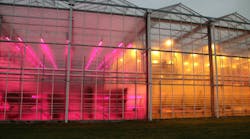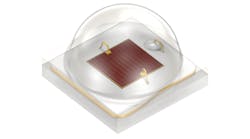Ams Osram has again added to its stable of horticultural LEDs, this time with a new product family that will co-exist with — not replace — the existing family, the company told LEDs Magazine.
The new Osconiq P 3737 has a slightly higher wall plug efficiency rating than the Oslon Square RM6, at 83.2% for a 660nm hyper-red model, compared to 78.8% for a hyper-red version of the Oslon Square series introduced last year.
As ams Osram explained last June with the advent of the Oslon Square line, small increases in chip efficiency can lead to larger percentage increases in lighting system efficiency.
The Premstaetten, Austria company claimed that the Osconiq P 3737 “can achieve 11% energy savings” when compared to rival chips that operate at 74% wall plug efficiency. It did not provide a comparative figure for its own 78.8% Oslon Square.
“With the same photon flux, this corresponds to €11 per €100 spent,” ams Osram said in a press release. “For a medium-sized greenhouse with annual electricity costs of more than €100,000, vegetable, flower, and other growers can save €11,000 per year by installing the latest LED lighting technology.”
Ams Osram noted that the Osconiq P 3737 delivers 90% of its original light output after 102,000 operating hours, giving it 'the longest lifetime of all LEDs for horticultural fixtures.'
The company also claimed that the chip’s higher photon flux levels can increase biomass and shorten crop cycles. It also noted that the Osconiq P 3737 delivers 90% of its original light output after 102,000 operating hours, giving it “the longest lifetime of all LEDs for horticultural fixtures.”
Despite all those advantages for the Osconiq family, it will not replace Oslon, an ams Osram spokesperson told LEDs. Both Osconiq and Oslon Square include 450nm (blue), 730nm (far red), and white chips as well as the 660nm (hyper red). Osconiq also has a 640nm (red) model, as does another arm of the Oslon family, called Oslon Optimal, which has a lower efficiency rating than Oslon Square. Optimal offers a compromise between efficiency and light uniformity and is positioned for use in vertical farms and for interlighting in greenhouses, the company told LEDs last year.
“Oslon will be offered in parallel to the Osconiq family,” the spokesperson said. “Depending on system requirements such as efficacy, costs, optics, fixture size, etc., both families can show different advantages. Generally Osconiq P 3737 targets highest efficacy systems. Oslon can be used for medium to high efficacy systems and can provide a primary wide beam lens (batwing versions) to avoid secondary optics.”
Osconiq uses an epoxy housing, compared to Oslon Square’s ceramic. Osconiq’s package size is 3.7mm² compared to Oslon Square’s 3mm², including the housing and the chip. Larger chips generally operate at a higher efficiency. Oslon Square houses a 2mm² die, and Oslon Optimal a 1mm² die.
Ams Osram is positioning the Osconiq P 3737 for use both in greenhouses — in toplights and interlights — and in vertical farms.
The company declined to provide pricing to LEDs. The spokesperson said the new Osconiq family “will be slightly more expensive” than the Oslon family, but that Osconiq’s “higher wall plug efficiency enables LED count reduction and will enable overall significant savings on the total fixture bill of materials.”
The announcement of the new Osconiq marks the latest development in a reviving market for horticultural LED lighting.
Ams Osram launched its general Osconiq line of LEDs for other applications in 2017. The P 3737 is the first horticultural chip in the series.
Follow our LinkedIn page for our latest news updates, contributed articles, and commentary, and our Facebook page for events announcements and more. You can also find us on the X platform.

Mark Halper | Contributing Editor, LEDs Magazine, and Business/Energy/Technology Journalist
Mark Halper is a freelance business, technology, and science journalist who covers everything from media moguls to subatomic particles. Halper has written from locations around the world for TIME Magazine, Fortune, Forbes, the New York Times, the Financial Times, the Guardian, CBS, Wired, and many others. A US citizen living in Britain, he cut his journalism teeth cutting and pasting copy for an English-language daily newspaper in Mexico City. Halper has a BA in history from Cornell University.









